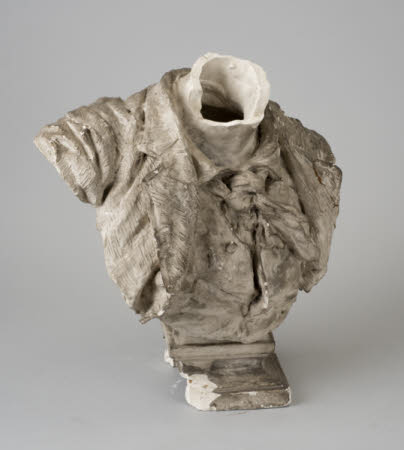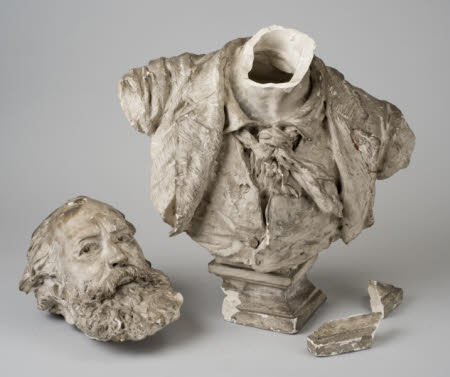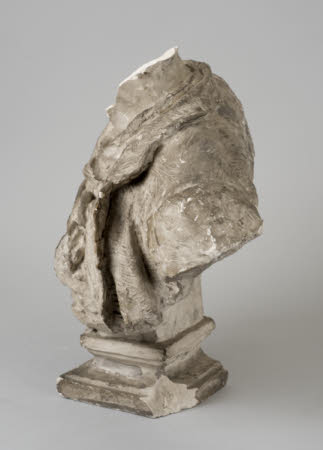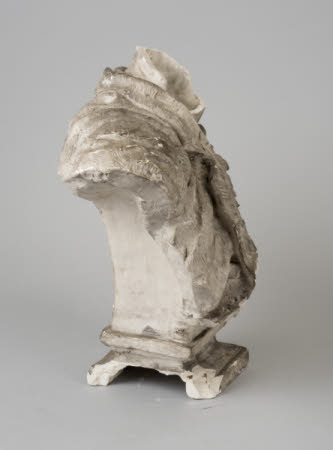Charles Gounod
Jean-Baptiste Carpeaux (Valenciennes 1827 - Courbevoie 1875)
Category
Art / Sculpture
Date
1873
Materials
Plaster
Measurements
520 x 530 x 270 mm
Place of origin
France
Order this imageCollection
Fenton House, London
NT 1449200
Summary
Plaster cast of the bust of Charles Gounod (1818-1893) the French composer, by Jean-Baptiste Carpeaux (1827-1875), 1873. Head turned to his right, Gounod has a full beard and moustache (head is now detached from the bust). He is dressed informally in an unbuttoned waistcoat, an open shirt with loosely tied neck scarf and a jacket. The bust is supported by a square socle. Carpeaux modelled his bust of Gounod during an extended visit to London in March 1873. This plaster cast may have been made in Carpeaux's studio in London in 1873, or at a later date in his studio in Auteuil, Paris.
Full description
This portrait bust of the French composer, Charles Gounod (1818-1893), was completed by Jean-Baptiste Carpeaux (1827-1875) towards the end of the sculptor’s life in 1873. Carpeaux visited London on two occasions in 1873, primarily to undertake a commission to produce a posthumous bust of Napoleon III, who had died in exile on January 9th of that year at his home in Chistlehurst, Surrey. Carpeaux stayed in London for three months to carry out further commissions for his English patrons, in particular Crouching Flora for Henry James Turner, Daphne and Chloe for Alexander Baring, 4th Baron Ashburton, and a number of busts. It was during this stay in London that Carpeaux’s friendship with Gounod flourished and a bust was commissioned. Gounod had fled to England from France at the outbreak of the Franco-Prussian War and lived with the eccentric singer Georgina Weldon and her husband William Henry Weldon at their home Tavistock House in Tavistock Square, Bloomsbury between 1870 and 1874. Georgina organised regular evening parties and concerts at her house which became a place of refuge for the exiled French. Weldon records a number of meetings between Carpeaux and Gounod in her diary of 1873, and relates how the two Frenchmen became friends in her book My Orphanage and Gounod in England (1882): ‘The Carpeaux had been in London all the winter; Gounod and Carpeaux had become great friends, and, when I returned from Brighton, the two great men had conspired to prepare me a surprise. Gounod took me to Carpeaux, to show me his bust all but finished.’ (p.104) Carpeaux undertook a few sketches of his sitter in black chalk as was his customary practice before modelling the bust. Sculpting commenced on 4 March 1873 while Gounod was composing a Miserere. According to Gounod, he sat between twelve and fourteen times for Carpeaux and the bust was completed by March 18th. In her biography of her father, Louise Clement-Carpeaux recalls how Gounod played on the piano while her mother sang and her father sculpted in clay or sketched. Carpeaux was obviously pleased with the bust and exhibited it in marble at the Royal Academy that summer (number 1415). However reviews of the bust were mixed, The Orchestra reported that ‘The celebrated sculptor has just finished a superb bust of Gounod’ (April 10 1873, p.24); whereas The Saturday Review gave a not so favourable review of the bust after the reporter viewed it at the Royal Academy: ‘M. Carpeaux has an unsatisfactory head of M. Gounod’ (July 12 1873, p.51). Gounod was apparently pleased with his bust and commissioned a further version in terracotta in 1875 from Carpeaux’s widow, Amelie. He recollected in 1876: ‘The twelve to fourteen sessions during which I posed helped me appreciate how much passion Carpeaux had for the great art to which he devoted his too short existence. As he was in his works, so he revealed himself in his conversation, ardent, impetuous, emotional and persevering; one felt the heat and swiftness of his design.’ The location of the marble version of Gounod’s bust that was exhibited at the Royal Academy in 1873 is currently unknown, but a number of stamped terracotta versions are held in public museums in America and in many provincial French museums. The sculptor, Sir Joseph Edgar Boehm was a great admirer of the work of Carpeaux. Following Boehm’s death in 1891 a studio sale was held by Christie Manson and Woods in which two works by Carpeaux were sold: the original plaster bust of Gounod (lot 106) and a terracotta bust of the artist Jean-Léon Gérôme (lot 107). The plaster model of Gounod’s bust was bought by Boehm’s former pupil, Alfred Gilbert, and later given to the Royal Society of Musicians of Great Britain. The plaster cast of Carpeaux’s bust of Gounod in the collection of Fenton House is not stamped and therefore probably not produced in Carpeaux’s atelier in Auteuil. It is possible that it is an early plaster cast taken from the original plaster model by Carpeaux in his London studio, before being sent to Auteuil for the production of further copies in marble and terracotta by his studio assistants. Anna Moore (January 2018)
Credit line
National Trust Collections (Fenton House)
Makers and roles
Jean-Baptiste Carpeaux (Valenciennes 1827 - Courbevoie 1875), sculptor
References
Draper 2014: James David Draper and Edouard Papet (eds.), The Passions of Jean-Baptiste Carpeaux (ex. cat.), New Haven and London 2014; venue: The Metropolitan Museum of Art, New York and the Musée d'Orsay, Paris 2014, pp.239-240. Cat 145 p.328. Poletti and Richarme 2003: Michel Poletti and Alain Richarme, Jean-Baptiste Carpeaux sculpteur: catalogue raisonné de l'oeuvre edité, Paris 2003, pp. 120-121 Wagner 1986: Anne Middleton Wagner, Jean-Baptiste Carpeaux Sculptor of the Second Empire, New Haven and London 1986, p.184 Corbeau-Parsons 2017: Caroline Corbeau-Parsons (ed.), The Impressionists in London French Artists in Exile 1870-1904 (ex. cat.), Tate Publishing London 2017; venue, Tate Britain Nov 2017 - May 2018, p. 184-5












